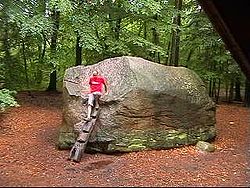
Giebichenstein
Encyclopedia

Stöckse
Stöckse is a municipality in the district of Nienburg, in Lower Saxony, Germany. It is situated in the forest "Krähe" between Langendamm and Steimbke.-Municipality Stöckse:...
, Germany, is one of the biggest erratic blocks
Glacial erratic
A glacial erratic is a piece of rock that differs from the size and type of rock native to the area in which it rests. "Erratics" take their name from the Latin word errare, and are carried by glacial ice, often over distances of hundreds of kilometres...
of Northern Germany. A picture of the Giebichenstein is part of the emblem of Stöckse.
There is the supposition, while during Wolstonian Stage the stone was deposited by glaciers as a part of a moraine
Moraine
A moraine is any glacially formed accumulation of unconsolidated glacial debris which can occur in currently glaciated and formerly glaciated regions, such as those areas acted upon by a past glacial maximum. This debris may have been plucked off a valley floor as a glacier advanced or it may have...
. Near Giebichenstein there are rests of a dolmen
Dolmen
A dolmen—also known as a portal tomb, portal grave, dolmain , cromlech , anta , Hünengrab/Hünenbett , Adamra , Ispun , Hunebed , dös , goindol or quoit—is a type of single-chamber megalithic tomb, usually consisting of...
, and at the stone there are rests of a stone age
Stone Age
The Stone Age is a broad prehistoric period, lasting about 2.5 million years , during which humans and their predecessor species in the genus Homo, as well as the earlier partly contemporary genera Australopithecus and Paranthropus, widely used exclusively stone as their hard material in the...
's hunter's camp.

